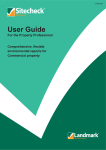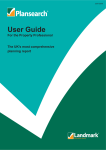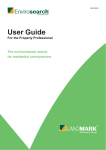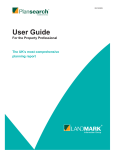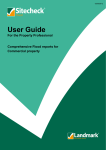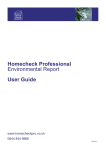Download User Guide - Bourse Company Services
Transcript
09/11/2007 User Guide For the Property Professional The UK's most comprehensive planning report Plansearch Plus User Guide Table of Contents Introduction – About this Guide 3 Why should I get a Plansearch Plus? 3 When should I get a Plansearch Plus? 4 How do I get a Plansearch Plus? 4 The Planning Process 5 What does my Plansearch Plus tell me? 6 How do I proceed now? 16 Appendix Appendix 1: Scope of Planning Applications 17 Appendix 2: Location Accuracy Used in Plansearch Plus 18 Appendix 3: Data sets Used in Plansearch Plus Appendix 19 Appendix 4: Ordnance Survey Legend 22 Appendix 5: The Search Code 25 2 Plansearch Plus User Guide 1. 2. Introduction - About this Guide 1.1 This guide has been prepared by Landmark Information Group Limited to inform and provide guidance to practitioners on how to use Plansearch Plus effectively and explain the benefits of it to their clients. 1.2 This guide will be regularly updated to reflect any changes to the product and to the legal or practical framework, where relevant. A copy of this guide is available free of charge from www.landmarkinfo.co.uk. Why should I get a Plansearch Plus? 2.1 Selecting and buying the right home can be a lengthy and costly process, so once your client has picked their new home it is important they are aware of any potential changes within the surrounding area before proceeding with the purchase. For example there could be plans to construct a telecommunications mast, a new nightclub could be opening, or there could be plans to build a block of flats or a factory nearby. The impact of such proposals could be substantial. They might ruin the view from the property, reducing its value, or reducing the prospective purchaser’s potential enjoyment of the property. 2.2 For the homebuyer, Plansearch Plus will reduce the potential for unwelcome surprises by providing detailed information about Land Use Policies in the neighbourhood. 2.3 For the practitioner, Plansearch Plus provides current and historical planning information in a user-friendly, illustrated report, which enables the practitioner to provide as much information as possible to the client prior to the transaction. 2.4 The standard local authority search (Con 29) focuses on the property for which the search has been commissioned, and provides no information beyond the boundaries of the property (other than for road and rail for which a 200 metres search is made). Equally, replies to Con 29 enquiries will not usually include the informative maps that are a feature of Plansearch Plus. 2.5 Plansearch Plus is designed to overcome the limitations of Con 29 by providing the following information for the property and surrounding area: Aerial Photo Planning Applications Land Use Designations Mobile Phone Masts Rights of Way Housing and Neighbourhood Crime Education Amenities Useful Information Contacts Details of each of these sections are given in section 6 of this guide. 3 Plansearch Plus User Guide 3. 4. 2.6 The planning history of land near to a person’s intended home may be important to the client. Whether it is an indication of future land use, an application for proposed development, or a valid planning permission for development, it is clearly best practice to provide as much relevant information as possible. 2.7 Obtaining a Plansearch Plus will give the practitioner high-quality current information which can be used to inform and advise their client on the intended purchase. It is often unwise for practitioners to rely solely on their own knowledge of the area. When should I get a Plansearch Plus? 3.1 Plansearch Plus is intended for domestic property transactions and can be obtained in connection with any domestic property transaction including purchase or re-mortgage. The report should be fully analysed before either the exchange of contracts or formalisation of any binding obligation. It should not be used or relied upon for any commercial property transaction. 3.2 Plansearch Plus can also be obtained on behalf of the seller and/or the current owner of domestic property wishing to discover planning activities in the area. For example prior to applying for permission to build a two storey rear extension, it will be useful to know where other similar proposals have been made, and how the local planning authority decided them. 3.3 A separate search should be made for each domestic property with its own postal address. How do I get a Plansearch Plus? 4.1 Plansearch Plus can be ordered by using one of our order forms or alternatively via our website at www.landmarklegalreports.co.uk. To obtain an order form or register for an account to order online please contact: Landmark Information Group Limited Legal & Financial The Smith Centre Fairmile Henley-on-Thames RG9 6AB Telephone: Fax: DX: E-mail: Internet: 0844 844 9966 0844 844 9980 154400 Henley-on-Thames 2 [email protected] www.landmarkinfo.co.uk 4.2 A separate search should be made for each individual property having a different postal address. 4.3 Order forms should be completed by including: The full postal address and postcode of the property. The name and Document Exchange (DX) number (if applicable) of the practitioner. The practitioner’s file reference and telephone number. A plan of the property (see paragraph 4.4 below). 4 Plansearch Plus User Guide 5. 4.4 If you are using an order form it is requested that a plan showing the location of the property is enclosed with your order. If a plan is not supplied there may be difficulties in identifying the location of the property and this may introduce a delay. 4.5 In normal circumstances a Plansearch Plus will be despatched to the practitioner within 24 to 48 hours of the receipt of the order. 4.6 Plansearch Plus is also available electronically, normally within 24 hours. The Planning Process The need for Plansearch Plus arises from the fact that the planning process can seem very complex. The report includes planning information of two types: one derived from local authority development plans and development frameworks, and the other from individual planning applications and decisions. 5.1 Development Plans and Local Development Frameworks The Local Development Framework is currently replacing Local Plans for local authorities in England. A Local Development Framework (LDF) is a folder of Local Development Documents that outline how planning will be managed in an area. An LDF includes a Core Strategy, Site-Specific Allocations of land, a Proposals Map and can also contain additional optional development documents such as Area Action Plans. Adopted Plans from the LDF will become the statutory plans for your area and will replace any other Development Plans for all or part of the area, including any Local Plan. Deposit Plans will be replaced by Submission Draft Documents which are likely to become the Adopted Plans, although further revised drafts may be issued at some future point before they are formally adopted. Because individual documents in the LDF will not cover every aspect of the existing Deposit and Adopted Local Plans the existing plans will remain until fully superseded. This process could theoretically take up to 8 years and planning policy documentation may become difficult to interpret in certain areas during this period. The system in Scotland and Wales will remain broadly unchanged with one adopted development plan and one submission draft plan covering a given area. Whilst the names of these documents and the areas that they cover may change, there will be little difference to the current system. 5.2 Plansearch Plus provides details of both the adopted Development Plans and adopted plans from the LDF giving policies and proposals specific to the address and surrounding area. It also includes the latest draft deposit plans and submission documents which will show the intended policies and proposals for the future. 5.3 Development Plans and Development Documents are the statutory documents prepared by local planning authorities that set out the policies and proposals for future development and use of land. They also incorporate the planning policies of central government. There are different types of local authority, but they all have a role in preparing the development documents for their area, whether they are, for example, District Council, County Council, Unitary Authority or National Park Authority. Plans can be substantial and very detailed, and subject to review and amendment. A plan goes through different stages before it is finalised (‘adopted’) the main stage being an alteration or replacement which has been proposed formally. The cycle from one ‘adopted’ plan to another varies considerably in practice, but is meant to be around 5 years. 5 Plansearch Plus User Guide 5.4 The Development Plan and Development Documents have important practical consequences. They provide the framework for consulting the public and other bodies on proposed land uses and development, and, once a plan has been formally adopted, it is the required starting point for determining individual planning applications. Development plans include general statements of policy, but they also include detailed policies which often relate to specific sites. For example, they might indicate zones suitable for housing, retail, industrial or commercial uses, or indicate conservation areas. In this way they show the likely future uses of land and indicate where development and use restrictions will be applied. They are therefore a crucial factor in determining the planning context of any piece of land. 5.5 Planning Applications The second type of planning information included in the Plansearch Plus report comprises individual planning applications. Applications for planning permission are submitted to the relevant local planning authority and their details are added to the planning register, maintained by that authority for public inspection. Applications must also generally be notified to local residents immediately adjoining the site, or advertised through a notice on the proposed development site itself. 5.6 A planning officer for the authority will consider the application, taking into account a wide range of factors. These will include the planning history of the property and relevant adjoining sites, the site’s specific characteristics, comments from local residents, and policies included or proposed in the development plan. In most cases a decision should be reached within 8 weeks of registration of the application. The decision will either be made by a committee of council members, or be delegated to the planning officer for determination. Unless acted upon, a planning permission will lapse after either 3 or 5 years, depending on whether it is an “outline” or “full” (sometimes called “detail”) application. Once a decision is made it too will be added to the planning register. 5.7 Plansearch Plus endeavours to include all applications of relevance, however we are unable to include some categories of application in the report. A list of those categories not reported is provided at Appendix 1. 6. What does my Plansearch Plus tell me? 6.1 General Information The Plansearch Plus report is based on the data sets listed in Appendix 3 to this Guide. The Practitioners attention is drawn to the update cycles for this information. 6.1.1 It should be noted that, although planning applications are updated weekly, it can be up to 6 weeks (occasionally longer) after initial registration with the local authority before an application appears in the Plansearch Plus report. 6.1.2 The map and aerial photograph on the front cover, along with the address details themselves, should immediately enable the practitioner to verify that the report has been correctly located on the subject property. If the practitioner has any doubts in this respect they should be raised immediately with Landmark or the supplying agent. 6.1.3 Local authorities sometimes have different interpretations of their boundaries and associated land use policy areas. Although these are usually minor, there can be small areas that are not claimed by either of the neighbouring authorities and therefore not reported upon in Plansearch Plus. 6 Plansearch Plus User Guide 6.2 6.1.4 Landmark Information Group is constantly working with data providers to improve the data sets and so the information available to Landmark may change from time to time. 6.1.5 Practitioners should not re-use old reports as planning applications and policies will be added to and changed continuously thus superseding the last report. The report is valid at the time it is delivered to the practitioner, and is supplied subject to Landmark’s Terms and Conditions. Aerial Photo The Aerial photograph shows a 250 metres radius area around the property. Occasionally no image will be shown as there are some areas of the country that have yet to be photographed, most notably rural Scotland. 6.3 Planning Applications This section comprises a map, showing application locations, and tables showing the application details. The map extends to 250 metres from the search centre for reports in an urban area and 500 metres from the search centre for reports in a rural area. It should be noted that, because of the size of map symbols it is sometimes necessary to group applications within 25 metres together under one symbol. Minor applications and applications with low location accuracy are not mapped. 6.3.1 A summary is included at the start of the section. Any large applications identified within 100 metres and small and minor applications identified within 25 metres are listed. This is followed by a table which gives a count of the number of applications identified in each classification for each search buffer. 6.3.2 Records are split into large, small and minor applications. Large applications are those which have an estimated value above £100,000. Minor applications cover things such as single storey extensions, conservatories, porches, signs and car ports. Large applications date from 1997, small applications from 1998 and minor applications from 2006. 6.3.3 Large and small applications are divided into 9 classifications as follows: • Agricultural. • Catering. • Civil Engineering, including demolitions. • Commercial (Industrial, Office, Retail). • Education, Health, Military, Municipal. • Power, Water, Telecoms, Waste. • Residential. • Sport, Leisure, Entertainment. • Transport. Minor applications are not classified but will appear in the summary table under the heading of "Minor Development". 7 Plansearch Plus User Guide 6.3.4 The reporting search buffers vary depending on whether the report is on a property in an urban or rural location as per the table below. Application type 6.3.5 Search Buffer Urban Rural Minor 100 metres 300 metres Small 250 metres 400 metres Large 300 metres 500 metres Low Location Accuracy 800 metres 1000 metres Following the summary section, the details of all the applications identified are listed in tables, split by application type and classification. The details revealed are: • ID The ID on the map showing the location of the record. This will be blank if the application falls outside of the map area. This column will not be included in the tables for minor applications and those with low location accuracy, as these records are not mapped. • Address The address collected for the application. • Distance/Direction The distance and direction from the search centre. This column will not be included in the table of applications with low location accuracy as their location is uncertain. • Reference The application reference number. • Date The application date as listed by the local authority. • Type The development type. Categories are: new build, refurbishment or repair, alteration or conversion, demolition, extension, fit out, works, listed building consent and power supply lines. Where no category has been provided this is noted as "not supplied". • Location Accuracy The accuracy with which the application is located (See Appendix 2). • Decision The application decision. Reported decisions are; detailed planning granted, outline planning granted, detailed planning refused, outline planning refused, application withdrawn and not applicable. Not applicable is used when the application is first provided and no decision has been made. Please note: Where an application is refused it is possible that it may later be granted on appeal. Landmark's data provider will continue to monitor refused applications only if it appears likely at the time of the original refusal that an appeal will be lodged. If there is a delay between the refusal and an appeal it is unlikely that any appeal result will be reflected. 6.3.6 Where no application reference or application date is shown the record is likely to be information gathered from the trade press or tender requests. In most cases these projects will be in the very early pre-planning stage or that the proposed works do not require planning permission. 8 Plansearch Plus User Guide 6.4 6.3.7 Road, rail, utility and large development applications often do not have definite addresses but are identified with general descriptions. As a result, this report may show such applications by reference to a single point rather than the whole length/area of the project. In many cases the projects will be about changes to existing infrastructure (e.g. road resurfacing and existing buildings), and therefore may be identified by using the map. However, in cases of ‘new build’, identifying the length/area of the project is more difficult. 6.3.8 Because of the way that large development sites are recorded with a single point reference, in some circumstances, applications for development will not be recorded in the Plansearch Plus report, even though the application site lies substantially within the search area. For this reason, for road, rail utility and large development applications, the Land Use Designations sections of the report should also be referred to, as this will give further clues as to the location of new development. We suggest that you then contact the relevant local planning authority for further information. 6.3.9 Some developments do not require an express grant of planning permission, perhaps because its impact on an area would be small, or because it would involve a land use which is very similar to an existing use. This sort of development often takes place under what are known as ‘permitted development rights’, and it is therefore often referred to as ‘Permitted Development’. Examples of permitted development rights include, changes to the inside of buildings, or small exterior alterations that do not significantly alter the volume or area of a building. 6.3.10 In some areas of the country permitted development rights are more restricted. This may be because land is within an area designated as a National Park, Area of Outstanding Natural Beauty or Conservation Area, or it may be because a local authority has formally decided to revoke or modify permitted development rights under what is described as ‘article 4 direction’. Development rights are also restricted where a listed building is involved. Land Use designations The information in this section is derived from development plans and documents obtained from the local planning authorities. The section is split into several sub sections depending on what planning policy documents are available for the area of the search. Please see section 5 of this guide for a brief explanation of Development Plans and Local Development Frameworks. 6.4.1 Additional documents within search area This sub-section lists planning policy documents which have been, or are in the process of being, published by authorities relevant to the search area. Information from these documents will not be included in Landmark’s data and therefore you may wish to research these documents independently. This list of development plans is based on boundary information available to Landmark at this time. As a result of boundary changes some plans relating to neighbouring authorities may therefore be shown. 6.4.2 Land Use Policies and Allocations This sub-section starts with a summary table listing policies identified within 200 metres of the search centre. If land use designations relating to Ancient Monument Sites, Conservation Areas, Area of Outstanding Natural Beauty, Green Belt, Area of Archaeological Importance, National Parks, Article 4 Directions, Norfolk & Suffolk Broads or Site of Special Scientific Interest/Nature Conservation are identified within 200 metres of the search centre they will be listed separately. 9 Plansearch Plus User Guide For ease of use, policies have been standardised into 10 categories. The summary shows a count of all the mapped policies of the latest adopted local plan and any subsequent deposit draft. Where the term ‘on site’ is used this is defined as within 25 metres of the centre of the search. 6.4.3 Land use policy classifications differ between local planning authorities and there are also significant differences in the way policies are expressed. For the purposes of the report, a standardisation process has been undertaken in order to produce a nation-wide classification system which has 10 categories in total. Each category will have associated policies, which determine the circumstances in which development may be permitted. Information about these can be obtained from the relevant planning authority. The following is an overview of the classifications used in the report. The 10 Categories are: • Housing Residential and other housing developments, including re-development and conversion. • Transport Transportation including planned corridors for new roads, minor and major road and rail alterations and a diverse range of cycle, pedestrian and parking policies. • Open Land Includes green belts, nature conservation areas, Sites of Special Scientific Interest (SSSI), etc. Policies normally relate to the preservation of such areas and restrictions on residential or any other development. • Heritage Environment Areas of many towns are designated as conservation areas under statutory powers. Additional statutory hurdles will be in place, and policy constraints are also often imposed concerning the types of construction that will be allowed. • Town Centre and Retailing Includes retailing areas, town centres and retail servicing areas. • Industrial and Commercial Includes commercial development sites, offices, warehousing, hotels and business and industrial use in general. • Community and Social facility Includes health, education, sport, leisure and social areas and allotments. • Waste, Pollution, Includes waste processing and disposal sites, land use for Minerals, Water and utility purposes (such as sewerage) and potential development Energy hazard areas. • Settlement Limit Limit of urban and village areas (ie the boundary with “rural” areas). • Other (Including mixed use) Areas and sites not covered by the previous classifications. It should be noted that these classifications may change over time. 6.4.4 Maps showing extracts from the adopted and deposit plans appropriate for the search area follow the summary with any land use policies highlighted. 10 Plansearch Plus User Guide 6.4.5 A brief description of the policies and land use designations identified are shown in a table. The direction and distance, classification, list of the policies and the description of the chapter in which they are found is included. If further information on specific policies is required you should contact the relevant local authority. Details may also be available from the local authority website. 6.4.6 Where policy numbers have been identified, these relate only to the distinct geographical areas shown on the map. You should be aware that all local planning authorities have general policies which apply either throughout the authority’s area and/or to particular land uses. These general policies are not included in the Plansearch Plus report. 6.4.7 For a comprehensive understanding of the policies and proposals affecting your area it is wise to contact the local planning authority or refer to their entire local plan. 6.4.8 In areas that have a two tier development plan system comprising the district local plan and the county structure plan, only the local plan is included in the report. 6.4.9 Local Development Framework This sub-section gives information on relevant documents from the Local Development Framework. It starts with a summary table listing policies identified within 200 metres of the search centre. A list of Development Plan Documents included in the section is also included. For ease of use, policies have been standardised into 11 categories. The summary shows a count of all the mapped policies of the latest adopted plan and any subsequent deposit draft. Where the term ‘on site’ is used this is defined as within 25 metres of the centre of the search. 6.4.10 As with Local Plans, land use classifications used in Development Plan Documents differ between local planning authorities and there are also significant differences in the way policies are expressed. For the purposes of the report, a standardisation process has been undertaken in order to produce a nation-wide classification system of 11 categories in total. Each category will have associated policies, which determine the circumstances in which development may be permitted. Information about these can be obtained from the relevant planning authority. The 11 categories are: • Housing • Transport infrastructure • Open Environment • Heritage Environment • Retail and Town Centres • Economy • Community and Social Facilities • Resources and Waste • Boundaries • Rural Settlement • Other Area/Sites 11 Plansearch Plus User Guide 6.5 6.4.11 Maps showing extracts from the adopted and deposit plans appropriate for the search area follow the summary with any land use policies highlighted. 6.4.12 Base mapping of an appropriate scale to suit the original document will be used. Although designations will be shown to the edge of the map window only those within the 200 metres buffer will be reported. 6.4.13 A brief description of the policies and land use designations identified are shown in a table. The direction and distance, classification, list of the policies and the description of the document in which they are found is included. If further information on specific policies is required you should contact the relevant local authority. Details may also be available from the local authority website. 6.4.14 For a comprehensive understanding of the policies and proposals affecting your area it is wise to contact the local planning authority or refer to the entire Development Plan Document. Mobile Phone Masts This section comprises of an Ordnance Survey map and a table containing details of any records revealed. 6.6 6.5.1 The map shows locations of any mobile phone base stations and masts identified within 250 metres of the search centre. 6.5.2 The table gives a site reference, the operator name and station type. Further details on mast height, frequency range, transmitter power, maximum power and transmission type are also included. 6.5.3 If no mobile phone base stations or masts are identified within 250 metres of the search centre the table is replaced by text stating “No mobile phone masts have been identified within 250 metres of the search location”. Rights of Way This section comprises of an Ordnance Survey map with footpaths, bridleways and other rights of way indicated. The map and data for this section is derived from Ordnance Survey Explorer maps. As well as indicating the public rights of way and footpaths, the map shows a range of other features. The full Ordnance Survey legend for these features is included at Appendix 4. 6.7 Housing and Neighbourhood This section comprises of housing and neighbourhood information as follows: 6.7.1 Housing Market Includes postcode sector based information on home ownership and housing type, and postcode based information on average property prices. Where there are less than 16 addresses in the postcode the property price information is derived from the wider postcode sector. The average price bands are calculated by Landmark’s data supplier EuroDirect, using the latest available data from Her Majesty’s Land Registry. They represent a snapshot in time as at the most recent date. 6.7.2 People Includes postcode sector based information on the predominant population type. Where there are less than 16 addresses in the postcode the information is derived from the wider postcode sector. 12 Plansearch Plus User Guide 6.7.3 Neighbourhood Information Includes details of the local authority for the search centre and local council tax bands. Local tax costs are compared to the national average. 6.8 Crime This section comprises of crime information and gives details of the crime reporting area and the number of households, population and the police force for that area. 6.8.1 The tabular information gives local totals under 6 categories of offence and relates these to national figures per thousand of population or, in the case of burglaries, per thousand households. 6.8.2 Theft Insurance Claim Rating This section indicates the risk of a claim being made for theft within the postcode sector. The risk is determined by comparing the number of theft insurance claims made to the number of properties in the postcode sector. • • • • “High Risk” is a sector with an average of 9 claims. “Medium Risk” is a sector with an average of 5 claims. “Low Risk” reflects few claims with an average of 2 claims. “Very Low Risk” indicates no claims records. The figures may be the result of one event or cumulatively over time and are indicative only. A sector may appear to have a higher risk due to repeated claims on a single property or group of properties. 6.9 Education This section gives information on state primary schools and state and independent secondary schools, further and higher education establishments. It comprises of an Ordnance Survey map, indicating the locations of any schools identified, and academic results tables containing details of each school revealed. Searches in Scotland and Wales use different data than searches in England and will contain a different table as described below. The search extends to 2 kilometres radius for searches in urban areas and 5 kilometres radius for searches in rural areas. 6.9.1 Primary Education Table (England) This table gives a map ID, School Name, School type, Age Range, Number of Pupils and Academic results in Maths, English and Science. Academic Results show the percentage of eligible pupils who achieved Level 4 or above in English, Maths and Science tests. (Level 4 is the standard expected of most 11 year olds). “-” may appear in the results section because: • There were 10 or fewer eligible pupils on the school roll. • The school has 10 or fewer day pupils of compulsory school age enrolled. • There are no results for reasons beyond the school’s control. 13 Plansearch Plus User Guide 6.9.2 Secondary Education Table (England) This table gives a map ID, School Name, School type, Age Range, Number of Pupils. Academic results give percentages of 5+ grade A* - C GCSE’s, 5+ grade A* - G GCSE’s and average GCSE/GNVQ points per pupil. Each student’s best eight GCSE/GNVQ results are used to give their GCSE/GNVQ point score. From these figures the average score for all eligible students is given. “-” may appear in the results section because: • Schools (except special schools) with at least one 15 year old pupil but no GCSE/ GNVQ entries for these. • Special schools with at least one 15 year old pupil but no GCSE/GNVQ entries for these. • No information available. 6.9.3 Sixth Form Education Table (England) This table gives a map ID, School Name, School type. Academic results give Number of entries, AGNVQ average points per student and AGNVQ average points per exam entry. The following link should be used for to obtain details of sixth form performance tables from the Department of Education and Skills website. http://www.dfes.gov.uk/performancetables/16to18_06/d3.shtml 6.9.4 Education Establishments (Scotland and Wales) This table gives a map ID, School name and address, School type, Age range and the agency that supplied the information. Academic results are not available for schools in Scotland and Wales however some information may be available from the local authority. The local authority details can be found in the contact section of the report. 6.10 Amenities This section comprises a map, showing amenity locations, and tables showing amenity details. The map extends to 2 kilometres from the search centre for reports in an urban area and 4 kilometres from the search centre for reports in a rural area. Only the nearest location in each amenity category is shown on the map. 6.10.1 Following the map the details of all the amenities identified are listed in a tabular form, split classification. The details revealed are: • Map ID The ID on the map showing the location of the record. This will be blank if the amenity listed is not mapped. • Amenity The type of amenity. • Name The name of the amenity. • The address of the amenity. Address • Distance/Direction 6.10.2 The distance and direction from the search centre. A complete list of all the amenity categories reported together with the maximum number of entries returned and the search radius for urban and rural reports is detailed in the following table: 14 Plansearch Plus User Guide Amenity Max. No. Reported Search Radius Urban Rural Eating & Drinking Restaurants 3 1km 2km Café’s & Snack Bars 3 1km 2km Fast Food 4 1km 2km Pubs, Bars & Inns 3 1km 2km Shopping Centres 2 2km 4km Supermarkets 2 2km 4km Markets & Convenience Stores 3 1km 2km Retail Outlets Grocers, Bakeries & Health Food 4 1km 2km Delis, Butchers & Fishmongers 4 1km 2km Newsagents, Confectioners & Off Licences 4 1km 2km Post Offices 2 1km 2km Letter Boxes 1 1km 2km Public Telephones 1 1km 2km Local Services Cash Machines 2 1km 2km Recycling Centres 2 2km 4km Libraries 2 1km 2km Places of Worship 2 1km 2km Halls, Day & Community Centres 2 1km 2km Allotments 2 1km 2km Hospitals 3 2km 4km Doctors 3 1km 2km Dentists 3 1km 2km Clinics & Health Centres 3 1km 2km Chemists 3 1km 2km Sports Clubs & Associations 2 1km 2km Sports & Leisure Centres 4 1km 2km Tennis & Squash Courts 2 1km 2km Golf Courses & Ranges 2 2km 4km Swimming Pools 2 2km 4km Healthcare Facilities Sports Facilities 6.11 Useful Information The Useful Information is a summary of the main points contained in this User Guide and is intended to help those analysing the report to understand its contents. 6.12 Contacts The contacts section gives details of contacts where more information can be obtained. 15 Plansearch Plus User Guide 7. How do I proceed now? Plansearch Plus constitutes what is known as a ‘desk study’, which is an information-gathering exercise. The practitioner should now discuss the implications of the information with their client. 7.1 Clear search or no perceived problems The search may reveal no entries of any concern whatsoever, and the practitioner may advise the client to proceed, safe in the knowledge that quality information has been obtained. Keeping the search with the file or deeds will assist if future reference needs to be made to the information disclosed at the time of the report. 7.2 Searches showing planning information of concern In some cases the search will reveal entries that may be of some concern to the purchaser or homeowner. We try to highlight significant entries in the summary page, but the report should be read fully to determine exactly what may be of concern to the buyer. The practitioner should discuss these issues with the client to decide whether further investigation or enquiry is required or desirable. 7.3 If further information is to be sought the practitioner should use the Contacts section to determine who the contact is, and contact the relevant organisation quoting the planning application reference or plan name, policy and chapter. 7.4 The decision to proceed, to undertake further investigations or to withdraw must be the client's, informed by the practitioner’s advice. This will frequently depend on factors unrelated to the planning information revealed by the Plansearch Plus report. Factors such as the cost of further investigations, the difficulty and delay involved in undertaking them, the accuracy and helpfulness of the further information revealed, the general timescale of the transaction and the client’s attitude to risk will all influence the decision. 16 Plansearch Plus User Guide Appendix 1 : Scope of Planning Applications The data suppliers have indicated that the following categories of application may be excluded from their data and consequently may not be included in Plansearch Plus. Please also note that the list provided may not be exhaustive. Application Type Remarks Boreholes Exploratory Circular 18/84 Development by the Crown, a government department or the Duchy of Cornwall. County Matters In those areas where there are two tiers of local authorities, most planning applications are dealt with by the district authority but some are considered and decided at county level. Listed Building (if full planning on list) A planning application and application of listed building consent should be lodged together, if needed. The report will just cover the planning application in this case. Some works (eg internal alterations) will only require listed building consent. Overhead Lines 17 Plansearch Plus User Guide Appendix 2 : Plansearch Plus Description Location Accuracy Used in Plansearch Plus Explanation GOOD These planning applications have been supplied with sufficient address detail to locate them to the actual site. It should be noted however that where the address relates to a larger site, the application can only be located to a single point within the site. For example, a school may cover a relatively large area with a number of buildings. In this case it is represented as a single point within the boundary of the school. In certain instances, direct verification from the relevant local authority is sought as to the correct location, and these applications are also classed under this description. FAIR Applications often relate to new sites which have not been given a postal address by the Royal Mail. Consequently, the local planning authority or applicant relates the site to an adjacent address. For example, “Land adjacent to No.2 High Street, Townsville”. In these instances, the application has been located to this adjacent address. APPROX In a small number of cases the address supplied with the application is insufficient to locate it accurately. Where the location of the road referenced within the application can be identified and it is less then 300 metres in length, the application is located to this road. WIDER AREA Occasionally the address supplied with the application is insufficient to locate it with any accuracy at all. However it is usually possible to identify the general vicinity of the site usually within a distance of 1000 metres. MULTIPLE SITES Located at one of the multiple sites supplied. In certain instances, an application is supplied with more than one address. In these instances, the application can only be located to one of the addresses supplied. Generally, such records may not involve an actual planning application. 18 Plansearch Plus User Guide Appendix 3: Data Sets Used in Plansearch Plus Title Remarks Source Data Type Data Range Update Cycle Section Crime This data set details the recorded totals for 6 key offences: Violence against the person; Sexual offences; Robbery; Burglary of a dwelling; Theft of a motor vehicle; Theft from a vehicle, as defined by Crime and Disorder Reduction Partnerships. Home Office Text Previous Financial Year Annually Crime Development Plans This data set is a listing of all the development plans published by Local Authorities and County Councils in England, Scotland and Wales. It includes not just Devplan Text Various Monthly Land Use Designations Local Plans, Unitary Plans and National Park Plans, but also details of Structure Plans, Mineral Plans, Waste Plans, Mineral & Waste Plans and Regional Park Plans. Education Establishments This data set contains information on addresses and types of educational DfES (Edubase) Text Scottish Text Education Last Academic Annually Education Annually Education Land Use Designations Year Text Executive Land Use Policies are collected from Local Authorities throughout Great Britain. Annually Year establishments. This data set is geocoded by Welsh Assembly Landmark. Local Plan Features Last Academic Last Academic Year Local Authorities Point, line, area & text Variable Variable Local Point, line, area Variable Variable Authorities & text Local planning authorities are required to prepare planning strategies for their area in accordance with Sections 36 and 54 of the Town and Country Planning Act 1990 (as amended) in England and Wales, and Section 2 of the Town and Country Planning (Scotland) Act 1997. Plans are produced by district councils, unitary councils and National Park authorities in which detailed policies are set out to guide development in the Local Authority area. The plans may include detailed proposals for individual sites as well as identifying areas suitable for housing, industry, retail, conservation or other land uses. The plan forms the statutory basis for planning decisions and provides a means of public consultation and control over development. Depending upon the stage of consultation with the public, Plans are unadopted (eg, ‘deposit’ plans) or adopted. Local Development Plans Land Use Policies are collected from Local Authorities throughout Great Britain. Local planning authorities are required to prepare planning strategies for their area in accordance with Sections 36 and 54 of the Town and Country Planning Act 1990 (as amended) in England and Wales and The Planning and Compulsory Purchase Act 2004. The Local Development Framework (LDF) is a non-statutory term used to describe a folder of documents, which includes all the local planning authority’s local development documents. An LDF is comprised of Development Plan Documents (which form part of the statutory development plan) and Supplementary Planning Documents Plans are produced by district councils, unitary councils and National Park authorities in which detailed policies are set out to guide development in the Local Authority area. The plans may include detailed proposals for individual sites as well as identifying areas suitable for housing, industry, retail, conservation or other land uses. Land Use Designations 19 Plansearch Plus User Guide Appendix 3: Data Sets Used in Plansearch Plus Title Mobile Phone Masts Remarks This data set provides a listing of mobile phone base stations and masts within the UK (excluding Isle of Man). The information Source Data Type Data Range Update Cycle Section OFCOM Point & Text 2006 As Notified Mobile Phone Masts DfES Text Last Academic Annually Education Annually Education Annually Education provided includes location and operator name, and further details on mast height, frequency range and power. Performance Tables (Primary The primary school performance tables have been published by individual local education Schools) authorities (LEAs) in respect of state schools in their area. All LEAs are required to publish the Key Stage 2 National Curriculum test results of 11 year old pupils in state school in England, together with certain background Year details for each school. This data has been geo-coded by Landmark. Performance Tables (Secondary Schools) This data provides information on the achievements of students in state and independent secondary schools. They DfES Text Last Academic Year include GCSE and GNVQ results for 15 year olds (students in their final year of compulsory schooling) and come from the awarding bodies concerned. The information contained in this dataset provides only part of the picture of each school’s overall achievements. The tables should therefore be considered alongside other important sources of information such as Ofsted reports, school prospectuses and Governors’ Annual Reports. This data has been geocoded by Landmark. Performance Tables (Sixth Form) This data set includes all state and independent schools with sixth forms and DfES Text Last Academic Year Further Education sector colleges with results in England. Each entry provides information about the achievements of students over the current academic year in General and Vocational A and AS level examinations, key skills at Level 3 and in a number of other advanced and intermediate qualifications. This data has been geo-coded by Landmark. Planning Applications Applications for planning permission submitted to local authorities. Developments not requiring planning permission are excluded. This data is collated, classified and geo-coded by Landmark. Barbour ABI Points of Interest This data set contains PointX locations for points of interest and contains records from various provenance. PointX data as a whole has a coverage of Great Britain (excluding the Isle of Man). The data has been geocoded by Landmark. Point X This data set gives a breakdown of home ownership in the area (privately owned, mortgaged and rented, council or housing trust rented) and the type of housing in the area (detached, semi detached, terrace, maisonette, flat) and shows a range for the average property price. It also indicates the predominant population classification by postcode. EuroDirect Postcode Level Housing and Resident Profiles Point & Text Since 1997 (large),1998 (small) and 2006 (minor) Weekly Planning Applications Point N/A Quarterly Amenities 2001 Bi-annually Housing and neighbourhood & Text Text 20 Plansearch Plus User Guide Appendix 3: Data Sets Used in Plansearch Plus Title Remarks Source Data Type Data Range Update Cycle Section Postcode Sector Insurance Claim Ratings - Theft This data set is supplied by Crawford and Company and contains postcode sector based theft insurance claim ratings. Postcode sectors are supplied as digital polygons, to which insurance claim ratings are applied. The rating system has five levels, and is determined by the number of theft insurance claims made within the postcode sector. Four levels range from ‘Very Low’ to ‘High’, whilst the fifth category represents postcode sectors that have too few properties contained within them to make an assessment. Crawford & Co Polygon & Text From 2000 Quarterly Crime Ordnance Point,line & Text From 2001 Bi-annually Rights of Way Rights of Way Derived from Ordnance Survey 1:25,000 Explorer maps. Survey 21 Plansearch Plus User Guide Appendix 4 : Ordnance Survey Legend 22 Plansearch Plus User Guide Appendix 4 : Ordnance Survey Legend 23 Plansearch Plus User Guide Appendix 4 : Ordnance Survey Legend TOURIST INFORMATION 24 Plansearch Plus User Guide Appendix 5 : The Search Code Search Code Landmark Information Group has registered with the Property Codes Compliance Board and undertakes to comply with all the requirements and obligations contained within the Search Code of Practice. Important Protection The Search Code provides protection for homebuyers, sellers, conveyancers and mortgage lenders, who rely on property search reports carried out on residential property within the United Kingdom. It sets out minimum standards which organisations compiling and/or selling search reports have to meet. This information is designed to introduce the Search Code to you. By giving you this information, Landmark Information Group is confirming that they keep to the principles of the Search Code. This provides important protection for you. The Code’s main commitments The Search Code’s key commitments say that search organisations will: x x x x x Provide search reports which include the most up-to-date available information when compiled and an accurate report of the risks associated with the property. Deal promptly with queries raised on search reports. Handle complaints speedily and fairly. At all times maintain adequate and appropriate insurance cover to protect you. Act with integrity and ensure that all search services comply with relevant laws, regulations and industry standards Keeping to the Search Code How search organisations keep to the Search Code is monitored independently by the Property Codes Compliance Board and complaints under the Code may be referred to the Independent Property Codes Adjudication Scheme. This gives you an extra level of protection as the service can award compensation of up to £5,000 to you if you suffer as a result of your search organisation failing to keep to the Code. Contact Details The Property Codes Compliance Board Telephone: 020 7917 1817 Email: [email protected] You can also get more information about the Property Codes Compliance Board from our website at: www.propertycodes.org.uk Please contact our Customer Service team on 0844 844 9966 if you would like a copy of the full search code. 25

























